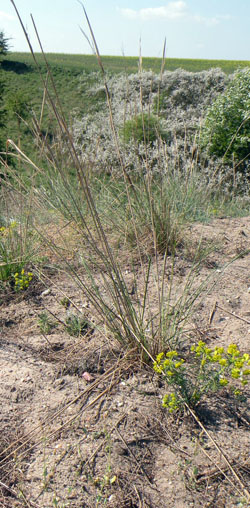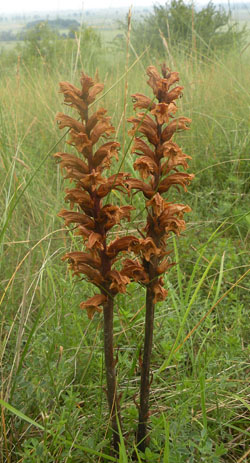The Ujście Warty Natura 2000 site is at the mouth of the Warta River. With a size of 33,297.35 ha, it was established to protect both a bird sanctuary as well as the natural habitats of the area.
It includes a broad floodplain formed by the confluence of three rivers: Warta, Oder, and the smallest of the three - Postomia. It is a huge complex of extensively used humid meadows, well-hydrated rushes, oxbows, ponds, willow scrub, various types of riparian forests, alder and oak-hornbeam woods. The Warta Mouth National Park, formerly the Słońsk Nature Reserve that is part of the Natura 2000 site, is one of the most valuable wetlands in central Europe. At least 35 bird species listed in Annex I of the Birds Directive occur here. Among the many species inhabiting this area during breeding season are: Shelduck Tadorna tadorna, Greylag goose Anser anser, Northern shoveler Anas clypeata, Spotted crake Porzana porzana, Gadwall Anas strepera, Great egret (Ardea alba), Eurasian coot Fulica atra, Black-winged stilt Himantopus himantopus, Eurasian oystercatcher Haematopus ostralegus, Common redshank (Tringa totanus), Tufted duck Aythya fuligula, Little gull Larus minutus, Little tern Sterna albifrons, White winged tern Chlidonias leucopterus, Black tern Chlidonias niger, Aquatic warbler Acrocephalus paludicola, Common pochard Aythya ferina, Common snipe Gallinago gallinago, Black-headed gull Larus ridibundus, White stork Ciconia ciconia, Black stork Ciconia nigra, Corn crake Crex crex, Red-backed shrike Lanius collurio, Barred warbler Sylvia nisoria, Tawny pipit Anthus campestris, Bluethroat Luscinia svecica, Wood lark Lullula arborea, Ortolan bunting Emberiza hortulana, Common crane Grus grus, Mute swan Cygnus olor, Grey heron Ardea cinerea and many others.
The reserve has 11 natural habitats listed in Annex II of the Habitats Directive. The best represented among them, are: oxbows and natural eutrophic ponds; rivers with muddy banks with Chenopodion rubri and Bidention vegetation; hydrophilous tall herb fringe communities of plains and of the montane to alpine levels; alluvial forests of willow, poplar, alder and ash, as well as xerothermic grasslands.
Adjacent to the Warta Mouth National Park are other important natural areas with some form of protection: part of the Warta Mouth Landscape Park, the "Lemierzyce", "Pamięcin" and "Dolina Postomii" nature reserves, as well as the Słońsk Ramsar-listed sanctuary and several environmental use areas.
In addition to extensive wetlands, the area includes many sites with thermophilous vegetation at the edges of the Oder and Warta river valleys. The best preserved complexes of xerothermic grasslands, fringe and thermophilous plants, as well as forested slopes are found in the southern part of the area near Górczyca, Owczary, Pamięcin and Laski Lubuskie.
Four main areas of concentrated xerothermic habitats have been designated for conservation activities as part of the project.
Czarnów
This area is a fragment of the Oder valley's gentle slopes that run between the villages of Żabice and Czarnów. The slopes face in a northerly direction with inclines of 20° - 30°. They are transected by small ravines, where xerothermic grasslands evolved. Brown soils developed on a substratum of sandy till.
The slopes are about 50% covered by thermophilous shrubs and pine trees with thermophilous species as ground cover. Non-arboreal assemblages are represented by the aforementioned xerothermic grasslands, as well as thermophilous sandy grasslands and fresh meadows with a large proportion of xerothermic species.
The Czarnów sub-area does not have many rare xerothermic species. However, it is a natural sanctuary of thermophilous habitats in the valley of a large river. It significantly increases the biodiversity of the surrounding agricultural landscape and decreases the isolation of xerothermic species' populations. Of the more interesting species that occur here are: Pulsatilla pratensis, Primula veris, Silene otites and Helichrysum arenarium.
The main threats to Czarnów are natural succession and afforestation. Two environmental use areas are found on the slopes of this site - "Długa Murawa" and "Murawka". The entire area is also part of the Warta Mouth Landscape Park.
Górzyca
This site includes a fragment of the Oder River valley's edge with a northern and western exposure at inclines of 20° - 40°. Small erosional ravines cut across the area. Brown soils developed on the slopes of sandy till.
Thermophilous shrubs, pine plantations and deciduous forests with thermophilous species growing as ground cover comprise 60% of the slope. Non-arboreal assemblages are represented by xerothermic grasslands of the Potentillo-Stipetum and Adonido-Brachypodietum associations, as well as the Sileno-Festucetum thermophilous sandy grasslands. One of the more valuable thermophilous plant complexes in the area, it represents typical examples of xerothermic grasslands. The dynamic mosaic of grasslands, fringe, shrubs and thermophilous forest species significantly increases the biodiversity of the surrounding agricultural landscape. Among the rare species occurring here are: Stipa capillata, Eryngium campestre, Prunella grandiflora, Melampyrum arvense and Campanula sibirica.
The main threats are natural succession and afforestation, as well as trash dumping by local residents. The slopes are also irregularly burned by the residents, which significantly delays the process of succession and as a result, benefits the maintenance of the grassland. Proposals have been made many times to put the site under protection as an environmental use area. The entire area is also part of the Warta Mouth Landscape Park.
Owczary
This site is comprised of a cluster of ravines cutting across the slopes of the Oder River valley. It is characterized by a very diverse terrain. The slopes' inclines vary between 5° - 45° with mainly south and southeast exposures.
Brown soils rich in calcium carbonate developed on slopes of clay till.
The vegetation is a dynamic mosaic of thermophilous habitats, from Adonido-Brachypodietum and Potentillo-Stipetum association xerothermic grasslands, Sileno-Festucetum thermophilous sandy grasslands and thermophilous species of the Arrhenatherion alliance meadows, to fringe and shrub species, Fraxino-Ulmetum riparian forests on the slopes, thermophilous oak groves and Pinus-Brachypodium pinnatum woodlands.
This is undoubtedly one of the best preserved and largest complexes of thermophilous vegetation in Poland. It is a model example of habitats 6210 and 91F0. Thanks to the grazing that has continued here for years, the grasslands have been preserved in an ideal state. Many rare species occur here: Stipa joannis, Anthericum liliago, Eryngium campestre, Orobanche caryophyllacea, Campanula sibirica, Campanula bononiensis, Scorzonera purpurea, Stipa capillata, Thesium linophyllon, Oxytropis pilosa, Helicopsis striata and many others.
54% of this area is privately owned by the Naturalists' Club. The remainder is owned by the State Treasury and managed by the Agricultural Property Agency. Extensive grazing by sheep, horses and goats occurs on 75% of the area. Mowed meadows comprise 10%. A small fragment consists of an agricultural field used to raise rare species of weeds. The entire area can be considered the Naturalists' Club's private reserve, under its care for over the past dozen or so years. Two environmental use areas are found in the segment owned by the National Treasury: "Owczary I" and "Owczary II".
The site is threatened in places by the encroachment of Robinia pseudoacacia.
Pamięcin
Pamięcin includes the lower stretch of an extensive dry valley directly connected to the Oder River valley. The valley is transected by many ravines running east to west. Xerothermic vegetation often covers these fairly steep and high slopes. The remaining, flatter area is used mainly as agricultural fields.
The thermophilous vegetation covering almost 50% of the terrain is represented primarily by the Potentillo-Stipetum and Adonido-Brachypodietum associations, thermophilous sandy grasslands, thermophilous shrubs and Fraxino-Ulmetum riparian woods on the slopes.
Next to Owczary, this is the second most valuable xerothermic grassland complex in the region. Model and exceptionally species-rich patches of habitat 6210 are found within its borders.
Many rare species grow here: Stipa joannis, Anthericum liliago, Eryngium campestre, Orobanche caryophyllacea, Campanula sibirica, Campanula bononiensis, Stipa capillata, Thesium linophyllon, Oxytropis pilosa, Helicopsis striata and many others.
About 50% of this sub-area is owned by the State Treasury and managed by the Agricultural Property Agency. There are two environmental use areas here - "Laski I" and "Laski II" - as well as the "Pamięcin" reserve. A small fragment of the State Treasury owned land is administered by the State Forests National Forest Holding (Ośno Lubuskie Forestry Division). The remaining terrain is privately owned and 99% of it is intensively cultivated for agricultural use. The entire area is within the borders of the Warta Mouth Landscape Park. Its main threats to the non-arboreal xerothermic vegetation here is the spread of thermophilous shrubs, the encroachment of Robinia pseudoacacia and biogenic runoff from the cultivated farm fields.









